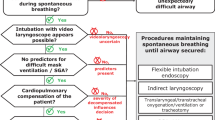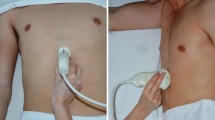Abstract
Purpose
To propose a way to safely perform endoscopic nasopharyngoscopy in ENT outpatient clinic during the COVID-19 pandemic.
Methods
This manuscript highlights the importance of endoscopy in daily ENT clinical practice, which is a pivotal procedure in the diagnosis of many head and neck pathologies. However, since the beginning of the COVID-19 outbreak, the authors have witnessed a drastic reduction (91%) in the use of endoscopic nasopharyngoscopy at their institutions. In fact, it is considered at risk of contamination for healthcare professionals, as any upper airway manipulation procedure.
Results
In the “Back approach to the patient” for endoscopic nasopharyngoscopy, the operator positions himself behind the patient and faces the monitor. The endoscopist, not being positioned in front of the patient, should, therefore, be less exposed to airborne transmission of SARS-CoV-2 virus.
Conclusion
This simple variation of the physician’s position during endoscopic nasopharyngoscopy could potentially reduce the risk of contagion since the operator is not in the trajectory of droplets and/or aerosols.
Similar content being viewed by others
Avoid common mistakes on your manuscript.
Nasal endoscopy is one of the most often performed ENT procedures in outpatient clinic, just thinking that an American insurance company reimbursed $86.3 million for 559 547 nasal endoscopies in 2016 [1]. This diagnostic modality plays a fundamental role in the daily clinical practice of the otolaryngologist. Indeed, especially if associated with new technologies such as narrow band imaging, it represents a pivotal tool in the early diagnosis of neoplasms of the nasopharyngolaryngeal district and for the follow-up of patients who have already undergone treatments for head and neck cancer [2].
However, endoscopic nasopharyngoscopy is considered a procedure at risk for 2019-novel coronavirus (SARS-CoV-2) contamination for the ENT specialists, as all procedures that have the potential to aerosolize aerodigestive secretions [3]. In fact, it seems that the virus spreads primarily through droplets and/or aerosols, which are inevitably created during every upper airway manipulation procedure [3, 4]. This has led to a drastic reduction in the use of endoscopy over the last few months; and the activity data of the Otolaryngology Department of the Civil Hospital of Sanremo confirm this trend. Between March and April 2019, 416 endoscopic nasopharyngoscopy were performed, compared to the mere 38 procedures performed in the same time span in 2020. There was, therefore, a 91% reduction in performing this procedure.
In this scenario, the authors would like to recommend the use of the Back approach to the patient to carry out endoscopic nasopharyngoscopy. This method of performing endoscopy, used often by some consultants at our institutions, seems to be a simple and useful technique to minimize the risk of contagion by the health worker during the coronavirus disease 2019 (COVID-19) pandemic.
The patient is admitted to the outpatient clinic only after having carefully washed the hands, wearing gloves and surgical mask. After sitting, the patient is asked to lower the mask and uncover the nose only. Nasal anesthesia is then performed with spray or with cottonoids soaked in anesthetic (e.g., Lidocaine 2%). In addition to reducing the discomfort of the nasal passage of the endoscope, the anesthetic, reaching the pharynx, also inhibits pharyngeal reflexes and, therefore, the risk of spreading droplets.
The operator, after wearing the enhanced personal protective equipment [5], positions himself behind the patient and faces the monitor (Fig. 1). This simple variation of the position of the physician during the execution of the endoscopy, which is traditionally carried out with the patient in front and the monitor behind or to the side of it, would in our opinion reduce the risk of contamination. In fact, in this way, the operator is not in the trajectory of droplets and/or aerosolization.
Finally, we recommend avoiding and postponing all endoscopic procedures through the oral cavity, such as stroboscopy, considering the safest nasal route for the endoscopic evaluation of ENT patients in the COVID 19 era.
Reference
Hur K, Ference EH, Wrobel B, Liang J (2019) Assessment of trends in utilization of nasal endoscopy in the medicare population, 2000–2016. JAMA Otolaryngol Head Neck Surg 145(3):258–263
Di Maio P, Iocca O, Cavallero A, Giudice M (2020) Performing the nasopharyngeal and oropharyngeal swab for 2019-novel coronavirus (SARS-CoV-2) safely: how to dress, undress, and technical notes. Head Neck. https://doi.org/10.1002/hed.26230(Epub ahead of print)
Kowalski LP, Sanabria A, Ridge JA et al (2020) OVID-19 pandemic: effects and evidence-based recommendations for otolaryngology and head and neck surgery practice. Head Neck. https://doi.org/10.1002/hed.26164(Epub ahead of print)
Hennessy M, Bann DV, Patel VA et al (2020) Commentary on the management of total laryngectomy patients during the COVID-19 pandemic. Head Neck. https://doi.org/10.1002/hed.26183(Epub ahead of print)
Di Maio P, Iocca O, De Virgilio A et al (2019) Narrow band imaging in head and neck unknown primary carcinoma: a systematic review and meta-analysis. Laryngoscope. https://doi.org/10.1002/lary.28350(Epub ahead of print)
Author information
Authors and Affiliations
Corresponding author
Ethics declarations
Conflict of interest
The authors have no conflict of interest to disclose.
Additional information
Publisher's Note
Springer Nature remains neutral with regard to jurisdictional claims in published maps and institutional affiliations.
Rights and permissions
About this article
Cite this article
Di Maio, P., Traverso, D., Iocca, O. et al. Endoscopic nasopharyngoscopy and ENT specialist safety in the COVID 19 era: the back endoscopy approach to the patient. Eur Arch Otorhinolaryngol 277, 2647–2648 (2020). https://doi.org/10.1007/s00405-020-06093-6
Received:
Accepted:
Published:
Issue Date:
DOI: https://doi.org/10.1007/s00405-020-06093-6





